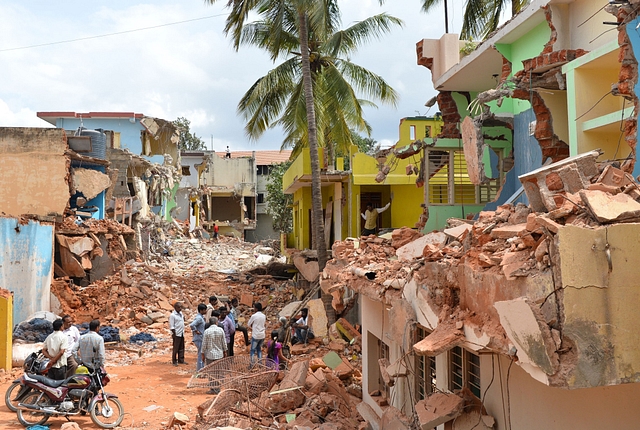
Demolition Woes In Bangalore: City Planners Take Note
It took a deluge for civic authorities to wake up to the issue of water logging and realise that something, somewhere was seriously wrong.
This August has been a cheery month for officials of Bruhath Bengaluru Mahanagar Palike (BBMP) and Bangalore Development Authority (BDA). They have been on a demolition drive, for the entire month, taking down illegal buildings, left, right and centre. Of course, it took them a deluge, caused by incessant drizzle in the last week of July, to wake up to this civic issue and realise that something, somewhere was seriously wrong.
The drive, with the intent of razing illegal structures that were encroaching lakes, lake beds and storm water drainage systems, has affected many homes belonging to middle-class households. The BBMP later named two malls, Gopalan Arcade in Rajarajeshwari Nagar and Orion Mall in Rajaji Nagar in the demolition list. The Karnataka High Court subsequently intervened and ordered the BBMP not to demolish multi-storey buildings without cancelling the plan as per law.
However, what is important to note is the enthusiasm with which the BBMP is demolishing these structures. Not all structures are illegal in the strictest of terms. Some of them are legal, atleast on paper because someone has bribed the officials to regularise what would otherwise be an encroachment. Construction of a building would require permissions and approvals from multiple authorities at all levels in the government. In Bangalore, a construction plan requires approval for water supply, sewerage, power connection, fire safety, height (from the Airports Authority of India), apart from other sanctions from the BBMP and the BDA.
A large number of citizens who have lost their homes in the demolition drive are working-class people, who might have taken heavy loans to buy a small apartment in the affected area. While it is the duty of a prospective buyer to check all documents related to the purchase, how would he or she know if the builder had bribed someone to get the documents?
Given the number of agencies that are involved in giving the green signal, one can roughly estimate how much corruption could be taking place. What the government must do now is stop this demolition spree and investigate those corrupt officials who let this happen in the first place, and then try to find a solution for the owners of the properties, rather than leaving them homeless. (Unlike the case where Payal Abdullah, former wife of Jammu and Kashmir politician Omar Abdullah was asked to vacate her government bungalow and the media claimed she was homeless.)
Demolition of illegal structures is common in India, as is corruption to get a building regularised. This happens practically in every city.
So what makes this case different?
The BBMP has based this drive on a revenue map that dates back to 1902. Yes. 1902. The beginning of the previous century. A 114-year-old map.
A 1911 map reveals that localities that form the core of this city today, such as Basavanagudi and Malleswaram, didn’t exist. In fact, they didn’t turn up until much later in a 1924 map of the city.
Below is a 1924 map of Bangalore city.
Now, someone who knows the city well would notice that the map lacks some of the crucial landmarks of the present-day Bangalore. In case you’re wondering, the water body marked as Koramangala Tank is today the National Games Village, which was built by the government for the National Games in 1997. It is largely inhabited by government employees, who have been allotted homes or the retired government employees who have bought houses there.
The other landmark, marked on the map as the Dharmambudhi Tank is the site of the present-day Kempegowda Bus Station (Majestic), the city’s central bus terminal. This too was built by the government in the 1960s before getting a revamp in the 1980s. Today, it houses BMTC and KSRTC’s central bus stations, as well as the interchange station between the east-west and north-south lines of the Namma Metro.
Now, will the government demolish the National Games Village too? Several prominent stadiums in the city stand where there was once a lake. More importantly, will the government demolish the Kempegowda Bus Station and Metro station because it also, technically encroaches a lake bed?
The nexus between builders, big and small, and the corrupt government officials, who allowed these constructions will not be affected by this drive. Those who were involved, made their money and nothing can be done about it now, unless a thorough investigation is launched into who was responsible and bringing them to book.
This isn’t the first time that Bangalore’s administration has bungled with a map. Back in 2008, the BBMP was constructing an underpass using precast elements at the Cauvery Theatre Junction on Sankey Road. What was supposed to have taken 72 hours, took close to five weeks, because it ended up rupturing a major water pipeline.
This isn’t a case unique to Bangalore alone. Unauthorised construction and poor planning has led to the Mumbai floods in 2005 and Chennai floods in 2015. Demolitions have happened in both cities post the deluge, with the administration taking up projects ranging from concreting roads to desilting rivers.
However, since these unlawful structures are legal on paper, thanks to the corrupt babus who let it happen, the solution would be to rehabilitate those affected before proceeding to turn buildings into rubble. One only hopes that better sense prevails among those in charge of city planning before the situation goes out of hand.